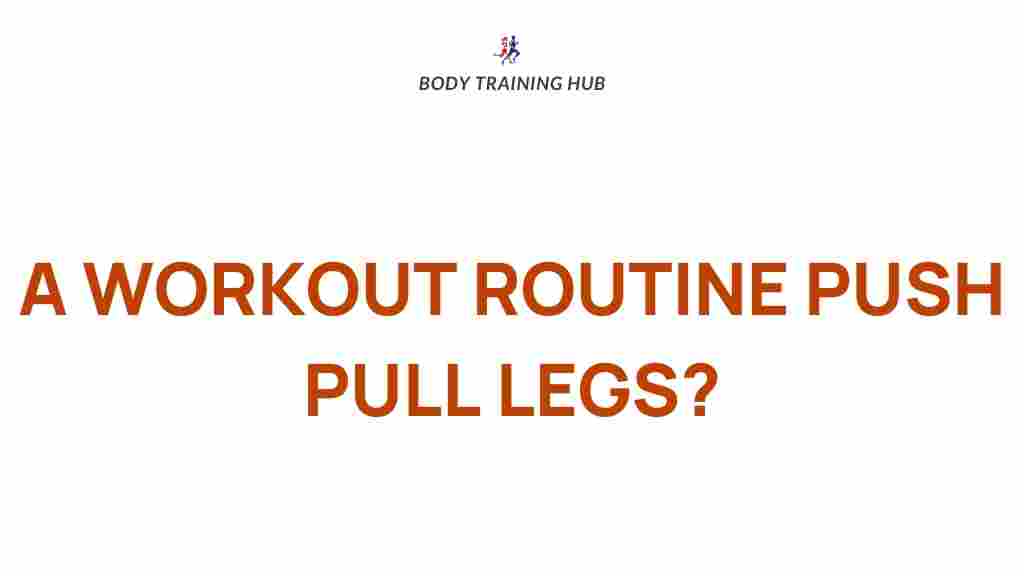Unveiling the Power of Push-Pull-Legs Workout Routine
The push-pull-legs workout routine is a highly effective and popular approach to strength training that can help individuals of all fitness levels achieve their goals. This method divides workouts into three fundamental categories: push exercises, pull exercises, and leg exercises. Understanding these categories can not only enhance your fitness journey but also ensure that you are targeting all major muscle groups efficiently. In this article, we will explore the intricacies of this workout routine, how to implement it in your fitness plan, and the benefits it offers.
Understanding the Push-Pull-Legs Workout Routine
The push-pull-legs (PPL) workout routine is a systematic approach that allows for comprehensive coverage of all muscle groups while providing adequate recovery time. Here’s a breakdown of each component:
1. Push Exercises
Push exercises target the muscles involved in pushing movements, primarily focusing on the chest, shoulders, and triceps. Common push exercises include:
- Bench Press
- Overhead Press
- Incline Dumbbell Press
- Tricep Dips
- Push-Ups
2. Pull Exercises
Pull exercises work the muscles responsible for pulling actions, mainly targeting the back, biceps, and rear shoulders. Some effective pull exercises are:
- Pull-Ups
- Barbell Rows
- Dumbbell Rows
- Face Pulls
- Bicep Curls
3. Legs Exercises
The leg day focuses on all major muscle groups in the lower body, including quadriceps, hamstrings, calves, and glutes. Key leg exercises include:
- Squats
- Deadlifts
- Lunges
- Leg Press
- Calf Raises
Creating Your Push-Pull-Legs Workout Routine
To create an effective push-pull-legs workout routine, follow these steps:
Step 1: Determine Your Training Frequency
Decide how many days a week you want to train. A common approach is to perform the PPL split three to six times per week. For instance:
- 3-Day Split: Push, Pull, Legs
- 6-Day Split: Push, Pull, Legs (repeat)
Step 2: Choose Your Exercises
Select a variety of exercises for each category. Ensure you include compound movements (which work multiple muscle groups) along with isolation exercises (which target specific muscles). For example:
- Push: Bench Press (compound), Tricep Extensions (isolation)
- Pull: Deadlifts (compound), Dumbbell Curls (isolation)
- Legs: Squats (compound), Leg Curls (isolation)
Step 3: Set Your Reps and Sets
Typical rep ranges for strength training are between 6 to 12 reps per set. For hypertrophy (muscle growth), aim for 3 to 5 sets per exercise. A sample structure could be:
- 3 sets of 8-10 reps for compound exercises
- 3 sets of 10-12 reps for isolation exercises
Step 4: Warm-Up and Cool Down
Always include a warm-up before starting your workout to prevent injury and enhance performance. A proper warm-up might involve:
- 5-10 minutes of light cardio
- Dynamic stretches targeting the muscle groups to be worked
Similarly, cooling down with static stretches can aid recovery and flexibility.
Step 5: Track Your Progress
Keeping a workout log can help you monitor your progress and make adjustments as needed. Consider tracking:
- Weights lifted
- Reps and sets
- Rest times
Benefits of the Push-Pull-Legs Workout Routine
The push-pull-legs workout routine offers numerous benefits that make it a preferred choice for many fitness enthusiasts:
1. Balanced Muscle Development
By incorporating push, pull, and leg exercises, you ensure that all major muscle groups are trained evenly. This balance helps prevent muscular imbalances, which can lead to injuries.
2. Flexibility in Schedule
The PPL routine allows for flexibility in scheduling. You can easily adjust the frequency of your workouts based on your personal commitments and recovery needs.
3. Enhanced Recovery
With the division of muscle groups, the PPL routine provides adequate recovery time for each muscle group. This recovery is crucial for muscle growth and overall fitness.
4. Time Efficiency
By focusing on specific muscle groups each session, you can complete your workout in a shorter amount of time, making it easier to fit into a busy lifestyle.
Common Troubleshooting Tips
Even with a structured push-pull-legs workout routine, you may encounter challenges. Here are some common issues and their solutions:
1. Lack of Progress
If you notice that your strength gains have plateaued, consider the following:
- Increase the weights you are lifting gradually.
- Change your exercise selection to introduce new stimuli.
- Ensure you are consuming enough protein to support muscle repair and growth.
2. Overtraining
Feeling fatigued or experiencing persistent soreness can be signs of overtraining. To combat this:
- Incorporate deload weeks where you reduce volume and intensity.
- Prioritize sleep and nutrition to aid recovery.
- Listen to your body and take rest days as needed.
3. Boredom with Routine
To keep your workouts engaging:
- Change up your exercises every 4-6 weeks.
- Add variety by incorporating different training styles, such as supersets or circuit training.
- Try new equipment or classes to keep your fitness journey exciting.
Conclusion
The push-pull-legs workout routine is a powerful tool for anyone looking to enhance their fitness and strength training. By understanding and implementing this structured approach, you can effectively target all major muscle groups, promote balanced development, and enjoy flexibility in your training schedule. Whether you are a beginner or an experienced lifter, the PPL routine can be adapted to meet your specific needs and goals. Start crafting your personalized exercise plan today and unveil the strength within you!
For more information about fitness strategies and strength training, check out this external resource.
This article is in the category Strength & Recovery and created by BodyTraining Team
